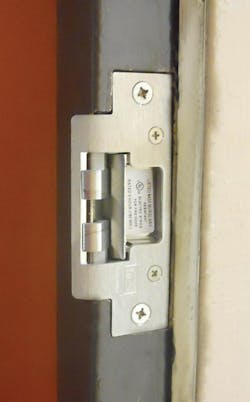Back Page, August 2022
20 Years Ago
Tom Gillespie installed an IEI DoorGard LS-1 push-button lock. Tim O’Leary looked at the Schlage E-Bolt deadbolt. Marks USA presented its full lineup of i-Que access control locksets. Steve Young presented an overview of side-impact airbag systems and deflated the myth about death by car-opening tool. Jerry Levine installed an LCN 4111 Smoothee door closer. Jerry also studied an ED5200S exit device by Corbin-Russwin. Recognition System suggested that biometrics could be a new locksmith profit center. The Key-Trax masterkey system was discussed. Locksmith ledger introduced facts on the 2003 Saturn Ion “G” key code series, then standard on many GM cars. Tiny serviced a 2002 Saturn that used the earlier B96 key blanks. Shane Crosby, Fire King International, showed how to open a Meilink fire safe. Gale Johnson reported on new motorcycle locks used on the 2002 models. Tiny returned to show how simple it is to use a Framon code machine. Locksmith Ledger also reported on an all-day access control class presented by CLARK Security.
10 Years Ago
Tim O’Leary covered the topic “Developing and Implementing an Emergency Lockdown Plan,” still timely today. O’Leary also wrote about the importance of conducting thorough site surveys for your commercial customers. Gale Johnson reported on high-end decorative Bluetooth residential locks from Keeler Products. CCL Security introduced its expanded line of Sesamee resettable padlocks. Jeremy Reeder opened and repaired a Canon Safe Executive Vault and replaced the malfunctioning safe lock. Jerry Levine provided tips for conducting a fire door inspection. The ABH product line expanded to include hospital latches, mag holders, door pivots, aluminum hinges, stainless steel hinges and additional door hardware accessories. Progressive Hardware’s detailed article provided “Everything You Ever Wanted To Know About Spindles.”
Installing No-Cut Electric Strikes
Conventional electric strikes require cutting out a portion of the door jamb to allow the latchbolt in the extended condition to exit the keeper, which permits the door to swing open. This visible portion of the conventional electric strike can detract from the overall appearance of an opening. The amount of material removed from the door jamb to accommodate the electric strike depends upon the size of the electric strike body, faceplate and the design of the keeper.
Equipping an outswing exterior door with a conventional electric strike exposes the keeper and the release mechanism, which detracts from the aesthetics. Another downside of installing a conventional electric strike onto an outswing exterior door is the keeper mechanism is exposed to the elements, including people who wish to gain unauthorized access. For some applications, a latch protector can be installed. This covers the electric strike and provides protection against unauthorized access.
Over the past several years, a number of electric strike manufacturers have introduced their versions of the “No Cut” centerline latch electric strike. Although the overall design of the “No Cut” electric strikes vary, the basic concept is no keeper cutout in the door jamb is necessary to release the door remotely. Depending upon the make and model, “No Cut” electric strikes can accommodate cylindrical lock latchbolts and centerline mortise lock latchbolts that have a one-half-inch or five-eighths-inch throw. Some “No Cut” electric strikes are designed to fit within the door jamb strike box.
The most common application for a “No Cut” electric strike is replacing the ASA strike plate used in hollow metal ANSI-prepped door jambs to release a cylindrical lock remotely. The ASA strike plate is 4-7/8 inches tall by 1-1/4 inches wide and normally has a lip 3-3/8 inches tall that allows the latchbolt to retract into the centrally located strike opening without marring the jamb.
The “No Cut” electric strike operates much like a standard electric strike. As the door is closed, the latchbolt and the deadlatch slide into the pocket as they slide over the faceplate lip. The keeper in the extended position keeps the deadlatch retracted, not allowing the latchbolt to be retracted and permitting the door to swing open. With the door in the closed position, the deadlatch remains retracted.
To accommodate the “No Cut” release mechanism, electric strike manufacturers had to develop a method to release the deadlatch to push the latchbolt back into the latch body. After the deadlatch is extended fully, the deadlatch and latchbolt can be pushed into the latch body to open the door. When released, each electric strike manufacturer’s “No Cut” keeper permits the deadlatch to fully extend. To complete the operation, the “No Cut” electric strike pocket is designed to enable the deadlatch and latchbolt to retract simultaneously as the door swings open.
Read the full article at https://locksmithledger.com/10735788
